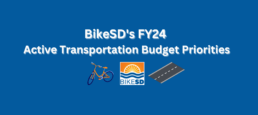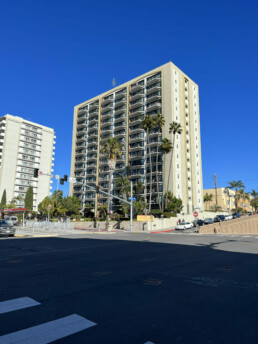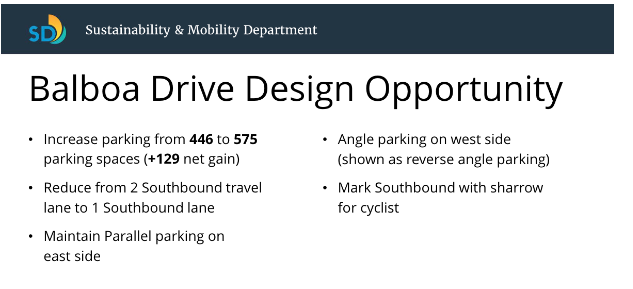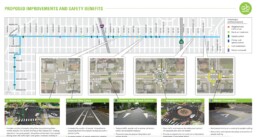As we enter the new fiscal year here in San Diego, we would like to thank all of the advocates that continue to demand safer streets, cleaner air, and a more livable San Diego.
As Barack Obama said, “A budget is more than just a series of numbers on a page; it is an embodiment of our values.”
The City’s adopted FY2024 budget of over $5 billion, unfortunately, shows that our elected officials do not truly value saving lives, combating the climate crisis, or pioneering transformative change. To illustrate this point, consider that the police department will receive $617.1 million, 30% more than the combined amount allocated to Parks ($207 million), Climate Action ($141.6 million), Homelessness ($81.7 million), and Vision Zero ($6.1 million).
The City did not listen to our demands.
Amidst this disheartening outcome, it is crucial to recognize the wins that deserve celebration. Out of our ambitious list of demands, the following initiatives will indeed receive funding in FY2024:
- $33 million towards Strategy 3 of the Climate Action Plan, which is looking to improve bicycling, walking, and transit as viable transportation options
- $2.25 million for the Interstate 5 Underpass bikeway connector (Linking two existing bike paths, the SR-56 and the Sorrento Valley Road multi-use bike path)
- $1.5 million to fix the City's most dangerous intersections
- $1.2 million to implement a traffic calming truck route in Barrio Logan
- $1.2 million to start work on the Normal Street Promenade
- $1.1 million to the Safe & Sustainable Transportation All Ages & Abilities Team (STAAT)
- $50,000 has been granted for the installation of bike racks citywide
- The implementation of the Downtown Mobility Plan will persist, progressing through Phase 3A1 by the conclusion of 2023
This list falls short of what is required to achieve our Vision Zero goal of eradicating traffic-related fatalities by 2025, as well as our Climate Action Plan objective of increasing bicycle mode share to 7%. It does, however, represent a modest beginning. We will continue to exert pressure upon decision makers at the City and County levels, ensuring that safeguarding lives and building a resilient community receive the attention they deserve.
There is a lot of work to be done; stay tuned to get involved with the FY2025 budget and all the other campaigns we are working on to make San Diego a more bikeable and livable city.
Anar Salayev
Executive Director
Bike San Diego
July 3, 2023
Statement by BikeSD on the San Diego City Council decision to widen SR-56
We are disappointed with the unanimous decision of the San Diego City Council to widen freeway SR-56. This decision contradicts the climate goals outlined in the Climate Action Plan, which calls for a reduction in vehicle miles traveled, and an increased mode shift to alternative forms of transportation.
Transportation is one of the largest sources of greenhouse gas emissions in the San Diego region, and widening freeways encourages more driving, which in turn leads to more emissions. The City Council chose to prioritize short-term convenience over long-term sustainability.
This decision, which was made despite Council President Elo-Rivera’s acknowledgement that “this is not a win from a climate perspective,” shows a lack of commitment to both climate action and vehicle mile reduction.
This is not the visionary leadership that San Diego needs to be at the forefront of our climate crisis.
Thoughts on AB 2097: Places for People, Not for Cars
AB 2097: Places for People, Not for Cars
It has been known for quite some time now that parking increases costs and perpetuates car-centric development. Parking, an amenity so overly subsidized, is seen as a natural right to many Americans. And because most people expect to easily find parking in most destinations, they opt to drive. This preference is then perpetuated by the large amounts of vacant land required to accommodate a parking lot – if a restaurant’s parking lot is 3x the size of the dining area, then all of a sudden it’s not very feasible to walk or bike to it. Take this design and scale it across a city, and you find yourself in a sea of parking lots (which is the very reality we live in today). All of a sudden, the only convenient way to get anywhere is with a car.
AB 2097 blocks city and county governments from imposing minimum parking requirements on housing developments within half-mile of public transit. Maximizing land use density allows for more homes, businesses, and amenities to be co-located at a human-centric scale. This makes it easier for people to walk and bike and easier for cities to provide reliable public transportation. I want to be clear that this is not a silver bullet – for true mode shift to occur, cities across the state need to truly allow for other modes of transportation. That means providing safe, all ages and abilities, protected bike lanes, that means increasing transit frequency and service hours, that means allowing for greater mixed use development, that means slowing down cars and ensuring that all road users feel safe in getting to where they need to go. Those steps, in tandem with this law, would really incentivize Californians to get around using mass transit and active transportation.
San Diego was one of the first cities in California to eliminate parking requirements for housing near transit, back in 2019. Research has shown that the city has subsequently seen an increase in affordable housing production (and higher housing production overall). In fact, one year after the reform was implemented, San Diego saw a fivefold increase in the total number of homes permitted through the density bonus program.
Of course there will always be people unhappy with change. A lot of pundits argue that this law will disincentivize developers from including any parking in their developments. Studies in Buffalo and Seattle, cities that struck down street parking in the 2010s, showed that a number of developments kept the same number of parking spots that they would’ve had before the reform. The key takeaway here is that AB 2097 gives developers and tenants options. Because developers aren’t required to build parking, their development expenses can be kept lower, incentivizing affordable housing. And tenants that do not own a car could move in and not have to pay more for an unused parking space.
These reforms are especially necessary given our current climate crisis. We know now that the post-war suburban (and exurban) experiment was a failure – ignoring all other problems, there is just not enough space to provide every single person a single family home with a front lawn, two car garage, driveway, and backyard swimming pool. Our sprawling cities require more resources to build, more money to maintain, and more miles to be driven. Not only is this ecologically unsustainable, but also economically irresponsible. As cities grapple with the looming climate crisis and work to reduce carbon emissions, they need to deploy every possible strategy – from reducing vehicle miles traveled to preserving ecological biodiversity. AB 2097 is one of these strategies.
Re: Sustainability & Mobility Department’s Balboa Drive Design Opportunities and Next Steps
Re: Sustainability & Mobility Department’s Balboa Drive Design Opportunities and Next Steps
Background
At the Balboa Park Committee meeting on October 6th, the City’s Sustainability and Mobility Department presented a proposal for redesigning Balboa Drive in Balboa Park.
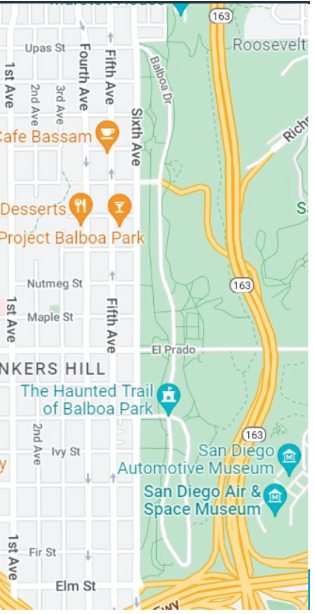
This redesign would align with the upcoming slurry seal project (#2323) which is slated to take place between April – October 2023. The presenters proposed increasing parking for the current 446 spaces to 575 (a nearly 30% increase) to “…offset parking loss on Park Boulevard…”
To provide some context here, the City recently approved a redesign of Park Boulevard, which would remove a general purpose lane and some parking in both directions to make room for bus-only and protected bike lanes. This Park Boulevard reconfiguration, which allows for a safer and more comfortable experience for pedestrians, bicyclists, and transit users, would result in a loss of ~175 parking spaces in a park that has nearly 7,500 free parking spaces – about 2%.
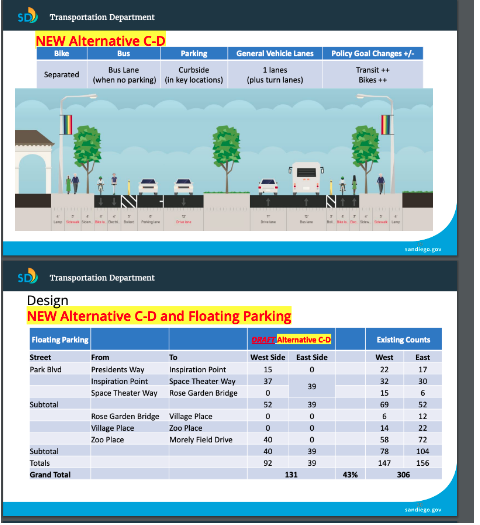
But what does the City decide to do to “offset” this monumental step forward…?
In order to offset this marginal loss of parking, the City has proposed adding more parking elsewhere in the parking, a goal that ignores the City’s own Climate Action Plan.
Worse yet, they propose to do this with angled parking, a redesign that not only further incentivizes automobile travel, but is actually associated with higher rates of collisions than parallel parking.

Problem
Our world is changing — every day we see the consequences of climate change impacting more and more people. In the state of California, thanks to eighty years of urban sprawl, subsidized parking, and an ingrained car culture, over fifty percent of greenhouse gas emissions come from on-road transportation. In an effort to reduce this, San Diego’s ambitious mode shift goals are looking to increase the percentage of bicycling trips to 7% (from 1.4%) and transit trips to 10% (from 4.5%) by 2030.
In parallel, we are facing the crisis of traffic violence: four of the most dangerous metropolitan areas for pedestrians are in California. San Diego has set ambitious Vision Zero goals: aspiring to have zero traffic related fatalities and severe injuries by 2025. Though, the reality, thus far, has looked more like this…
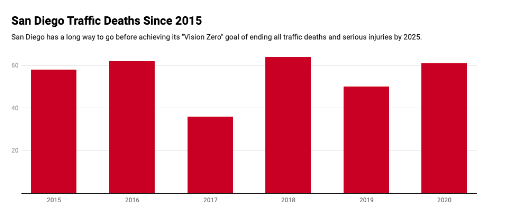
The changes made on Park Boulevard are a brilliant step towards achieving these ambitious goals. It makes biking, transit, and walking more comfortable and will encourage more San Diegans to opt for one of those options when traveling to (or through) our crown jewel.
But we’re adding more parking…?
Adding more parking disincentivizes other ways of transportation to the park, and inherently prioritizes car-based transportation, actively working against the City’s stated goals. The City repeatedly prides itself on the strides made with regards to the Climate Action Plan and Vision Zero, but refuses to accept that adding more parking during a climate emergency is absurd.
We’ve been hearing a lot of talk about climate action and vision zero. Unfortunately, when it comes down to making real, material change in San Diego, we need a dozen meetings to go forward and just one to go back.
Where do we go from here?
Here are the facts:
Balboa Drive is frequently used by bicyclists, families, and dog walkers to traverse the western mesa. We can see this when looking at heatmap data on both Strava and RideWithGPS.
Furthermore, according to the City’s Sustainability and Mobility team, the 446 parking spaces has a ~30% occupancy rate – which means, at any given time, only thirty percent of the parking spaces are utilized. City’s oftentimes plan to add new parking when utilization is above 85% – in this case, it seems like there’s plenty of parking for anyone that might need it
Finally, the 2012 Balboa Park Master Plan explicitly proposes that Balboa Drive (or some path alongside it) serve as a bicycle trail (below). This trail would connect neighborhoods to the Cabrillo Bridge, bowling greens, dog parks, and playgrounds.
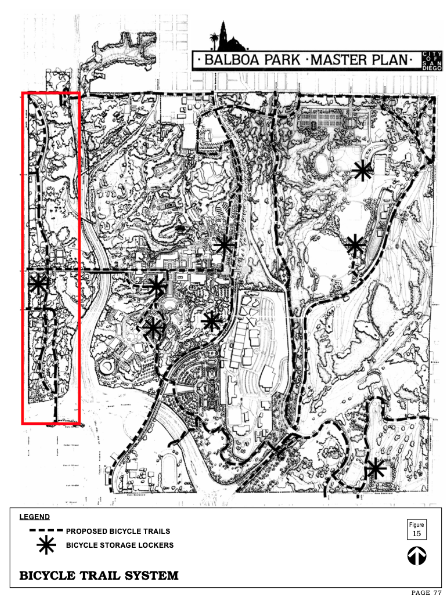
Given all this, here are BikeSD’s recommendations for Balboa Drive’s reconfiguration:
1. Slow down traffic
Reduce Balboa Drive’s width
Reduce the number of vehicle lanes from two to one
2. Enhance active transportation access
Add a bi-directional class IV cycletrack on the east side. This configuration is in line with the City’s “Class IV” first approach
3. Maintain curbside parking on west side
This could be all be completed as part of the next street resurfacing effort and would support:
- 2022 Climate Action Plan goals
- Vision Zero goals
- The Balboa Park Master Plan
We ask the City of San Diego to no longer offset the good it tries to do in one area by doing worse elsewhere. If we absolutely have to optimize parking availability, we recommend that the City set market-rate pricing for parking spots in Balboa Park and use this revenue to make further improvements to our crown jewel (More information here).
Georgia-Meade Bikeway
Some thoughts and next steps
Description
The Georgia-Meade Bikeway is a 3.5 mile segment of the greater North Park | Mid-City Bikeways, which is a 13 mile network of bike corridors that connect the Mid-City neighborhoods north of Balboa Park to Downtown. Meade runs horizontally from Kensington in the east to University Heights in the west, at which point the bikeway extends south via Georgia into North Park.

On the ground, Meade Avenue has been given a dramatic road diet, whereby roads have been narrowed to allow for Class II bike lanes. Though some might’ve preferred Class IV bikeways, the combination of Class II and punctuated traffic calming measures (roundabouts, raised crosswalks, and chokers) on this lower traffic volume road (compared to El Cajon Blvd., Madison Avenue, or Adams Avenue) should be sufficient. The improved road elements are meant to decrease the likelihood of a head on collision, reduce traffic speeds, and make active transportation both on and off the road a more comfortable experience.
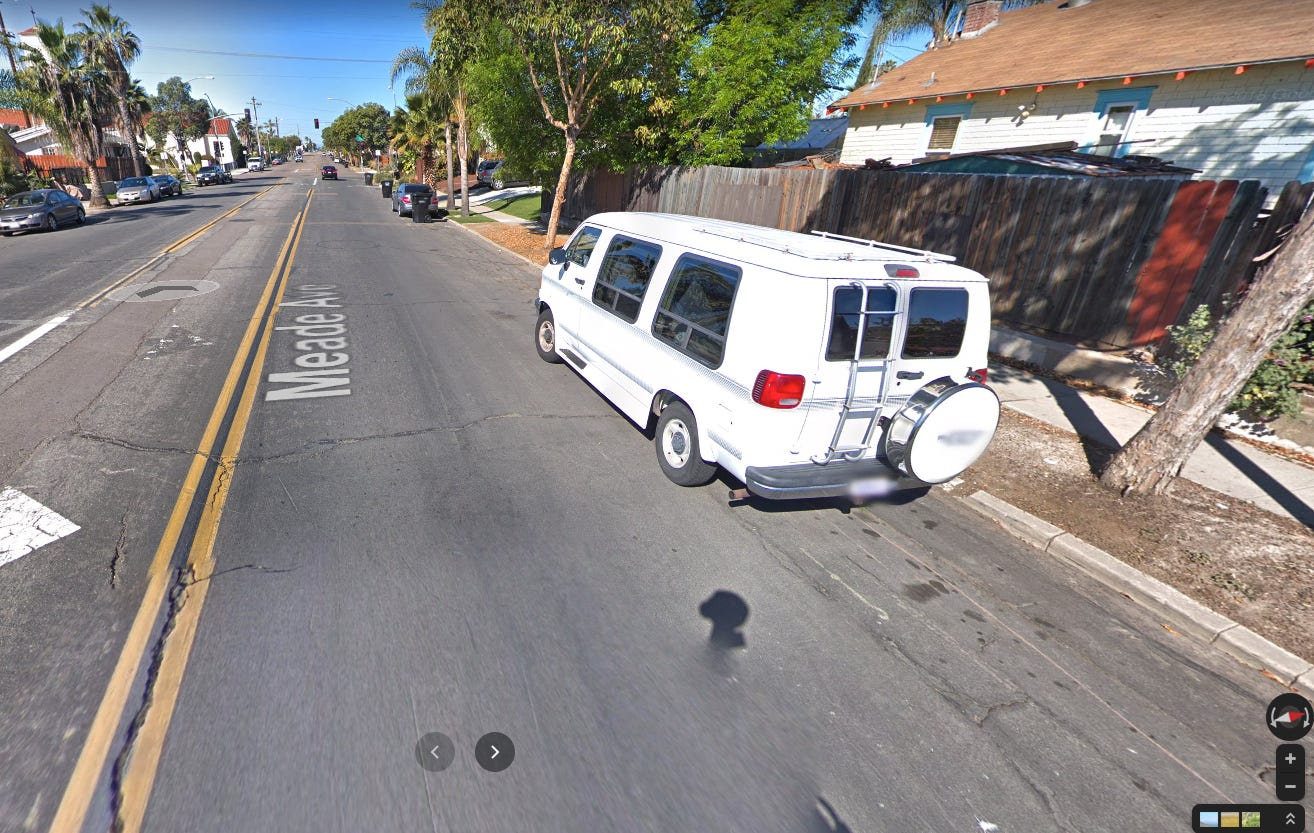
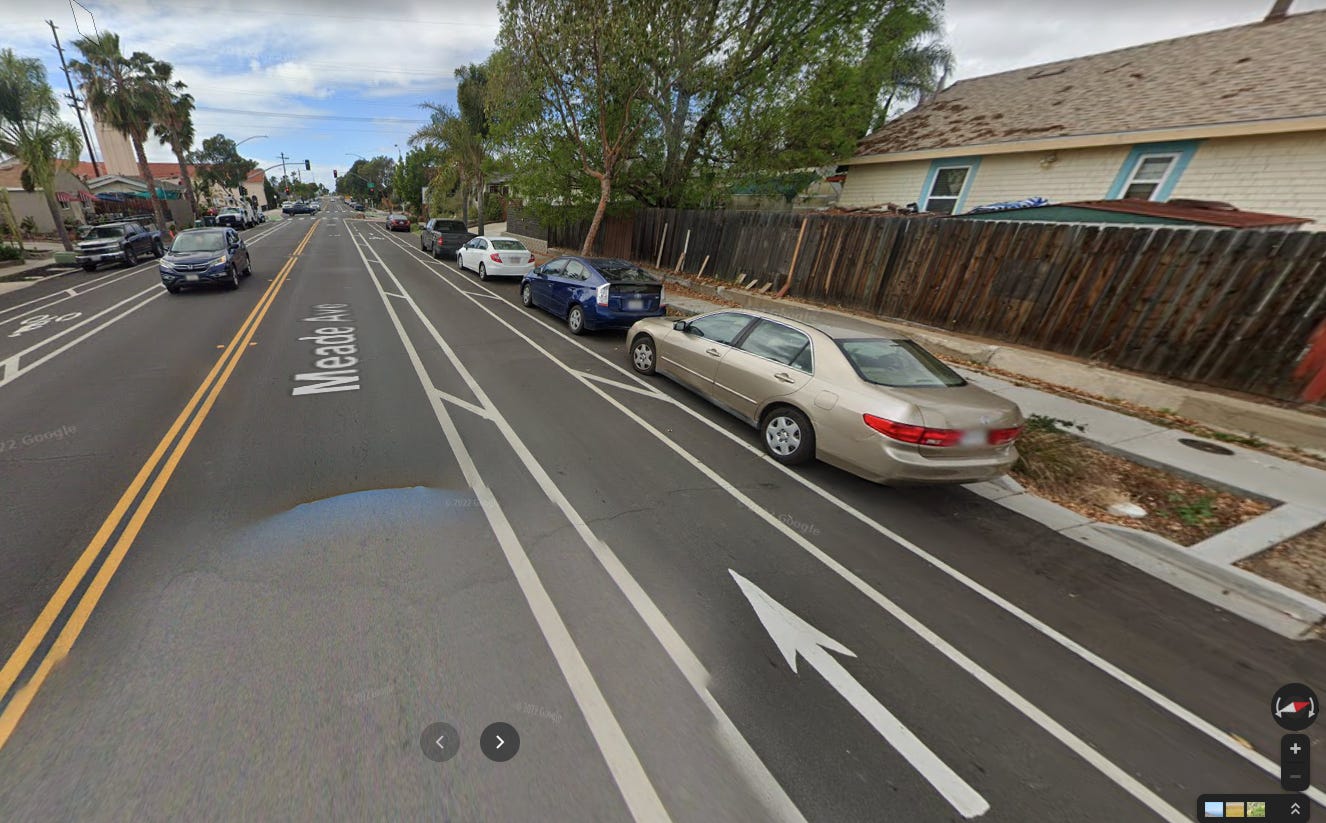
Benefits
The Mid-City neighborhood consists of over 130,000 residents spread out across some of the most densely populated communities in San Diego. On top of the population density, Mid-City also contains some of the most mixed-used communities in the city. This fusion of residential, commercial, and recreation makes Mid-City a great place to implement more pedestrian/bicycle oriented design. The Meade-Georgia Bikeway, allows residents from the more residential neighborhoods of east Mid-City to easily access the business districts scattered across the western portion (e.g. North Park via 30th Street, Adams via 35th, Normal Heights via 33rd, University Heights via Park Blvd., and the entire strip of businesses along the parallel boulevard, El Cajon).

By inducing greater demand across this east-west corridor, the Mid-City community can reduce vehicular traffic through these denser, pre-war neighborhoods. Most significantly, this greatly decreases the probability of vehicle-pedestrian collisions. Other potential benefits include reduced traffic congestion for those that absolutely must drive and decrease demand for parking in the various business districts (a popular point of contention when discussing non-car infrastructure). Some potential long term benefits are an improvement in air quality for residents living on or near the corridor, improved transit efficiency, and longer pavement lifecycles.
Though the city has not implemented any bike counters on this route, preliminary heatmap data from both Strava and Ride With GPS show promising bicycling activity along the Meade-Georgia Bikeway.
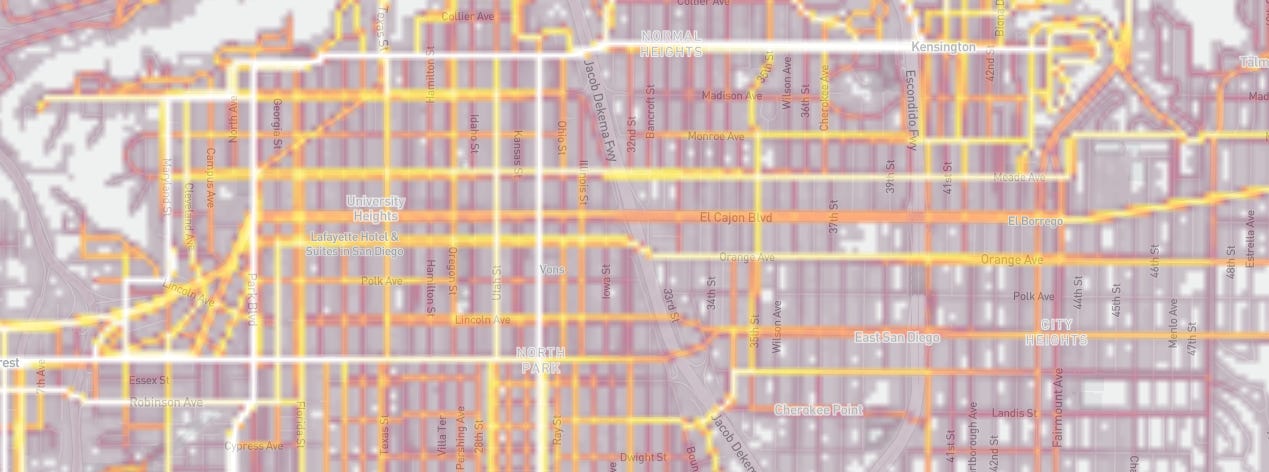

Feedback
I live in Kensington and use Meade almost every single day. Most mornings, I use it to get to the gym in University Heights. During the day, I use it to visit stores and businesses on 30th, Adams, or El Cajon to grab food and run errands. It’s even comfortable to ride along in the evening (if a little dark), on days where I’m coming back from seeing friends in Hillcrest, University Heights, or North Park. I love seeing fellow bicyclists ride past, residents walking their dogs, homeowners tending to their yard, and businesses opening up for the day as I commute between the small neighborhoods sprinkled across Mid-City.
The segment between Marlborough and Georgia is generally fine though there are a couple of things that can be improved.
- There are 10 roundabouts (or, traffic circles) scattered throughout Meade Avenue. Roundabouts are great: they slow down traffic, reduce head-on and side impact collision frequency and severity, and allow for decorative landscapes on what would otherwise be a patch of grey concrete. However, the striping pattern upon entry can lead to some confusion. In the picture below, you’ll notice that the bike lane abruptly ends and forces a quick merge into the sharrow right before entering the roundabout.
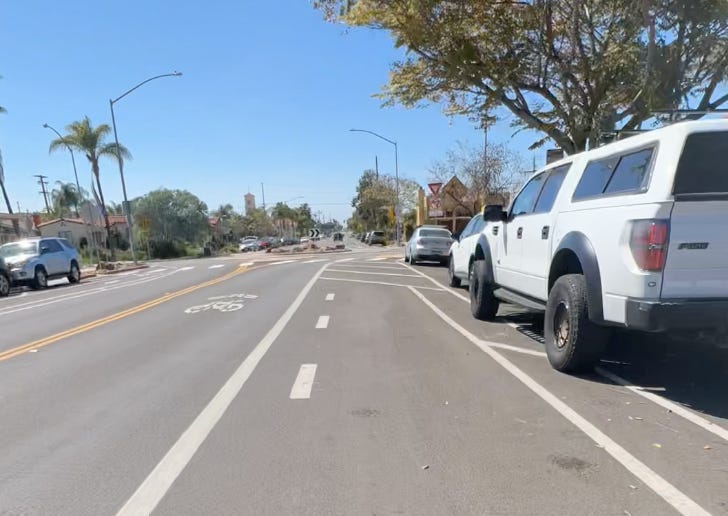 Generally, this maneuver can be done thoughtlessly, thanks to the relatively low volume of traffic present at any time. Nonetheless, I think more clear striping would go a long way in making Meade Avenue truly for all ages and abilities.Other cities have solved this problem by using colored (usually green) pavement and way-finding signals. In the case of the above roundabout entrance, I’d like to see the bike path curve into the traffic lane using green (or red, to follow the Dutch) paint and clearer way-finding.Here are a couple of examples from Austin and Salt Lake City(below) has done a great job of demarcating bike paths through wide intersections and sudden chokepoints.Austin, TX uses white stripes and sharrow markings to demarcate the recommended travel path for bicyclists across a wide intersection (nacto.org)An abrupt choke point in Salt Lake City, UT is clearly demarcated with a green lane and sharrow markings (nacto.org)
Generally, this maneuver can be done thoughtlessly, thanks to the relatively low volume of traffic present at any time. Nonetheless, I think more clear striping would go a long way in making Meade Avenue truly for all ages and abilities.Other cities have solved this problem by using colored (usually green) pavement and way-finding signals. In the case of the above roundabout entrance, I’d like to see the bike path curve into the traffic lane using green (or red, to follow the Dutch) paint and clearer way-finding.Here are a couple of examples from Austin and Salt Lake City(below) has done a great job of demarcating bike paths through wide intersections and sudden chokepoints.Austin, TX uses white stripes and sharrow markings to demarcate the recommended travel path for bicyclists across a wide intersection (nacto.org)An abrupt choke point in Salt Lake City, UT is clearly demarcated with a green lane and sharrow markings (nacto.org) - Meade Avenue intersects with 30th Avenue, another bikeway that was recently opened. Despite both of these individual bikeways being terrific places to ride, the junction between them feels more like an afterthought. In the picture below, I’m facing west on Meade with the intent of turning left onto 30th. To do so, I need to wait at this intersection, yield to oncoming traffic (because this is an unprotected left turn), and then turn through the intersection. Again, not a deal breaker, but an element that can certainly be improved upon, especially if we’re wanting to encourage people of all ages and abilities.
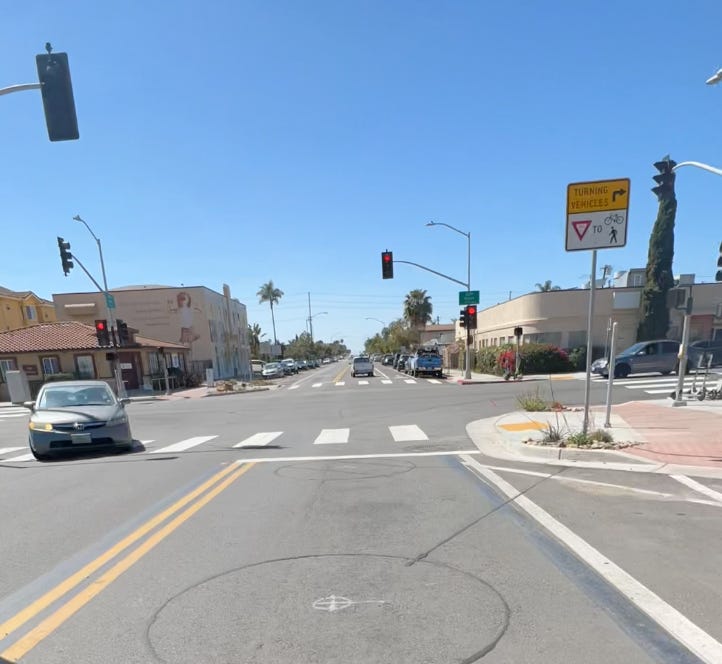 The typical strategy here would be to add a bike box to the right side of the intersection on 30th, so a bicyclist would position herself there when Meade Avenue is green and then continue south when 30th turns green. I think that requires too much waiting for what isn’t a terribly busy intersection. A more simple change would be to allow for a leading left turn signal which would benefit both left-turning bicyclists and vehicles. Obviously, the pedestrian crosswalk signal would defer to left turning vehicles.
The typical strategy here would be to add a bike box to the right side of the intersection on 30th, so a bicyclist would position herself there when Meade Avenue is green and then continue south when 30th turns green. I think that requires too much waiting for what isn’t a terribly busy intersection. A more simple change would be to allow for a leading left turn signal which would benefit both left-turning bicyclists and vehicles. Obviously, the pedestrian crosswalk signal would defer to left turning vehicles.
These issues are not specific to the Georgia-Meade bikeway - similar bicycle connectivity issues can be found throughout San Diego (in that interactive map, a lot of the blue and green lanes are extremely uncomfortable for bicyclists, e.g. El Cajon Blvd ).
Indeed, many of the existing bikeways may be great for commuting but fall short when trip chaining ( journeys that consist of numerous shorter trips) is required. As a remnant of mid-century modern urban planning, many bicycle corridors are focused on commuters, that is, getting riders from point A to point B, while not providing the necessary connectivity to comfortably access everything in between.
Next steps
San Diego’s bicycling network and culture are in its early stages: in 2018 the city was awarded Bronze status by The League of American Bicyclists, with one of the recommendations to achieve Silver status being:
Continue to expand the bike network and increase connectivity through the use of different types of bicycle facilities appropriate for the speed and volume of motor vehicle traffic on each road
It is encouraging that our current mayor, city council, and regional government (SANDAG) continue to push for more robust bicycle and pedestrian infrastructure. In the 2021 Regional Plan, there are dozens of projects dedicated to Active Transportation, one of the main categories of focus (Appendix A: Transportation Projects, Programs, and Phasing, Page 6), with $292 million allocated to regional bikeway projects. San Diego City is allocating $28.1 million towards their Vision Zero initiative, including $11.9 million for bicycle facilities (Adopted Budget Fiscal Year 2022, Volume 1: City Budget Overview, Page 19).
In fact, the city recently announced that Park Boulevard would receive protected bike lanes between Adams Avenue and University Avenue. This is a great extension of the existing east-west bikeways (including Georgia-Meade) that cut through Mid-City, allowing easy access to the many businesses and residences that line Park Blvd.
The next step is ensuring that the Park Blvd. improvements are expanded into and through Balboa Park. This would provide a safe path from Mid-City via Uptown into Downtown on a route where we are already seeing a large volume of bicycle activity (Strava heatmap and Ride With GPS heatmap). We would like to see this corridor upgraded to a Class IV bikeway. This would go a long way in encouraging an increase in bicycle trips between two significant commercial and residential cores, including numerous educational and cultural institutions along the corridor. If you would like to help push this forward, please visit the campaign page on BikeSD.org and write to the city!

